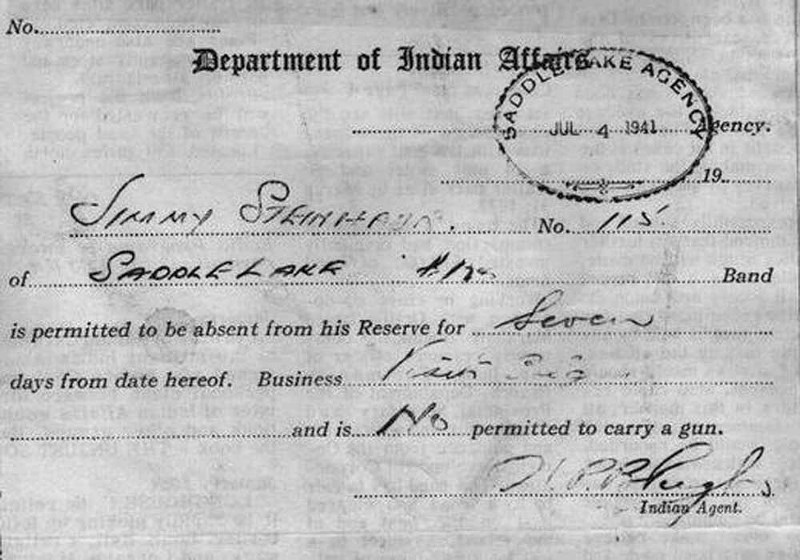Canada’s long history of racial segregation against its indigenous people included a period of time where the “pass system” was in place. This was and informal policy that was never actually codified in the Indian Act or put into law. This meant that any First Nations person who needed to leave his or her reserve required a signed pass from their Indian Agent, as well as a permit if they had intentions to sell goods such as grain. If they were found off of their reserve land without a pass, they were effectively sent straight to jail. This made travel for indigenous people a struggle, and was an effort by the Canadian government at the time to keep the First Nations people on their reserves and out of the “white” main towns. This system was put into action in 1885, at the time of the North-West Rebellion and ran for 60 years until it was finally taken out of practice. When this happened, the government made an effort to destroy essentially all evidence of these practices, such as the passes and permits to hide these acts of segregation.
Fast-forward 70 years; Filmmaker Alex Williams directs the film “The Pass System” a film about Indigenous history in the Pass system, which was viewed at the UNBQ (University of Blue Quills) this past Wednesday. The film is all about the history of this system, with first and second hand accounts of elders who experienced and lived under this system or have information that was passed down of their parents and grandparents about living under this system of segregation.
Alex Williams has interviewed many people across Canada on this issue, even filming a small portion of the film with a local man in front of the Blue Quills University, and he says that the purpose of this film is to educate everyone on this topic so everyone can understand and move forward from here. “Understanding is a key word when speaking about the pass system because there is some information about the pass system out there, but there is much more out there and we don’t have a full picture of what happened, and we won’t have that picture for quite some time. As we saw earlier, some people are just realizing the impact that it has had on Indigenous people. Non-indigenous people are in need of this understanding, because many indigenous people have known these stories for years, but the knowledge that many non-indigenous people have is incomplete. With the making of this film, I hope that we can improve everyone’s knowledge of these events.”
Williams is encouraging anyone that has old passes or permits to bring them forward so there are more examples of this time. They are extremely hard to find as the government intentionally destroyed nearly all of these documents when the system was no longer enforced. The best way to find insight and understanding into this topic is to talk to elders who lived through a part of this time period. Williams explained that part of the problem is that many people will not accept a “story” but would prefer to see documentation. “Many people want to see documentation as evidence, but if the government has destroyed this evidence, that makes it that much more important to hear from witnesses of what really happened.”
The effects that this system had on Indigenous people is still being felt, as Williams explained what The Pass System did to the two societies. “The Indigenous people needed permission to leave a reserve, which is obviously something that non-indigenous people didn’t have to deal with. This system ultimately sent two groups on opposite paths. The non-indigenous group which includes many ethnicities was on the path to freedom for land and prosperity, while the indigenous people were restricted to there reserve lands and sent on a path that did not allow them to move forward.”
This film is one of the avenues that will be utilized by Williams and other people looking into this issue to educate everyone on this period of segregation. The further we push this understanding, and although the goal of total harmony may be distant, the sooner both Indigenous and Non-Indigenous people realize the truth’s of this period, the sooner we can all move forward united.



